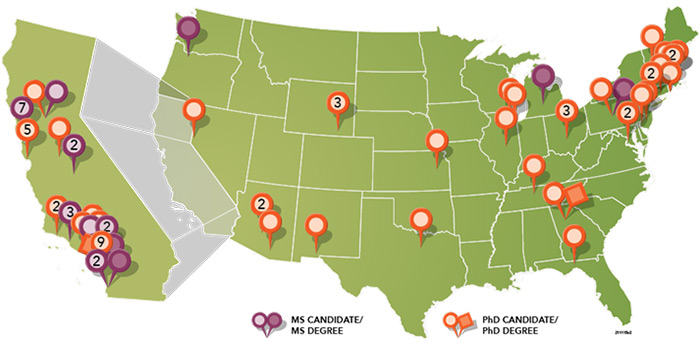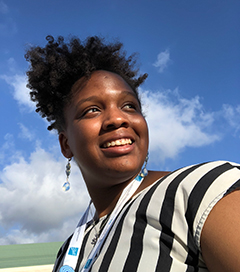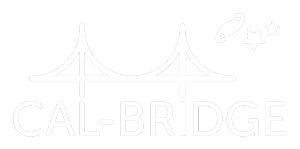The Strike for Black Lives: Growth of community in the Cal-Bridge program
Published: July 20, 2022
Publication: Physics Today. 20 July 2022. doi:10.1063/PT.6.5.20220720a
Authors: Alexander L. Rudolph and Carol Hood
The engagement inspired by the June 2020 call for action in academia has blossomed into change-promoting groups that the bridge program’s scholars both participate in and lead.
Events of 2020, including but not limited to the killings of George Floyd, Ahmaud Arbery, and Breonna Taylor, sparked a heightened awareness across the US of the racial inequities that permeate our society. Far from being isolated, events like those represent a pattern of systemic racism that exists everywhere, including in academia. In June 2020, a group of physicists named Particles for Justice called for a general STEM strike, the Strike for Black Lives. They were joined in that call by two other groups, Shutdown STEM and Vanguard STEM. The call was both in response to the continued murder of Black people at the hands of police and vigilantes and in recognition of the systemic anti-Black racism embedded in academia.
The purpose of the strike was for individuals and organizations to reflect on what concrete actions they could take to combat anti-Black racism in academia and our society. Whereas Black academics were encouraged to “take the day to do whatever nourishes their hearts,” organizers emphasized that “the strike is not a ‘day off’ for non-Black scientists, but a day to engage in academia’s core mission to build a better society for everyone.”
We report here on the outcome of meetings associated with the strike among the community of the Cal-Bridge program, which is designed to help rising juniors in the California State University (CSU) system successfully matriculate to STEM PhD programs. There was a particularly strong sense of community engagement among Cal-Bridge alumni. Our experiences may help those in other institutions to turn their ideas for change into concrete actions.
The importance of community
It is well known that human beings need the affiliation and attachment that come from belonging to a community; people survive and thrive when they feel socially connected.1,2 In the academic context, Mica Estrada, Alegra Eroy-Reveles, and John Matsui have described the key role that social inclusion and a sense of belonging play in promoting persistence among historically underrepresented (HU) students in academia, including underrepresented minorities (URMs), women in STEM, LGBTQ+ students, first-generation students, and students with disabilities, among others.3 In particular, the development of discipline identity, a form of social identity, has been shown to be a strong predictor of persistence in STEM.4–6
Historically underrepresented students’ sense of belonging is often obstructed by their perception that academia can be hostile or unwelcoming, with social norms that differ from their previous cultural experiences.3,7 Many HU students, especially URMs, are raised in a more collectivist culture than is acknowledged in academia, which tends to focus on individual achievement and often underplays the key role of collective work.8,9 The obstruction HU scholars face can take the form of racial tension, microaggressions, and insensitivity by majority members of the academic community who just don’t “get it” regarding the experiences those students have in academia.3,7 Collectively, those negative encounters can be perceived by HU students as an assault on their dignity. Social isolation and, frequently, departure from the academic world are the results.3
The participation and leadership by Cal-Bridge scholars and alumni in the program’s activities associated with the June 2020 Strike for Black Lives have led to an increase in their sense of belonging and inclusion that we expect will promote their continued academic and professional success.
Cal-Bridge responds to the Strike for Black Lives
The Cal-Bridge program is a partnership between STEM faculty in the CSU and University of California (UC) systems (see the article by Alexander Rudolph, Physics Today, October 2019, page 50). With more than 400 000 undergraduates on 23 campuses, 47% of whom are from URM groups, CSU is the largest, most diverse university system in the nation. The students and alumni of the Cal-Bridge program mirror that diversity, with 59% of the 182 scholars from URM groups and all but one scholar coming from one or more HU groups. The program has had great success. Almost two-thirds of scholars are currently enrolled in PhD programs in the UC system and elsewhere, and most of the rest are enrolled in master’s programs with plans to apply to PhD programs eventually. Two of the initial cohort of five scholars in 2014 have received their PhDs; both are now postdocs.

In response to the call for a general STEM strike on 10 June 2020, the Cal-Bridge program engaged all levels of the Cal-Bridge community by organizing two hour-long Zoom meetings, one for faculty and staff and another for students and alumni. Twenty-three Cal-Bridge students and alumni (23% of the total at that time) attended the scholars meeting, and 55 faculty and staff attended the faculty meeting. In both meetings the attendees broke into small groups for facilitated discussions of how to respond to the call for antiracist action.
On 24 June a group of more than 50 Cal-Bridge scholars, faculty, program staff, and university administrators gathered for an additional two-hour follow-up meeting to turn the ideas of 10 June into concrete actions. In the first hour, participants broke into groups to discuss the ideas each person was most excited about, and then those groups reported back to the larger group. The larger group identified the top actions to adopt and selected the participants and leaders to pursue each idea. For the second hour, participants broke into groups and turned the ideas into action plans, which would be carried out by the six groups described in the box below.
Action groups and their missions
(* indicates scholar-led)
- Outreach to community college and CSU students.* Develop and coordinate outreach efforts through the Cal-Bridge network and partners, encouraging students, especially Black students, to pursue STEM fields in high schools, community colleges, and universities.
- Diverse speaker series. Invite speakers to showcase future career paths for Cal-Bridge scholars and the contributions of scientists of color (including Cal-Bridge alumni), who can serve as role models. Give students opportunities to interact with those speakers. Discuss anti-racism and experiences of scientists of color. Provide seminar experiences for campuses that don’t normally have seminars.
- Space for Black mentors and mentees.* Design space for Black students to acquire skills, knowledge, and confidence through mentoring and practice to be successful in research and coursework.
- Mental health.* Create support groups for scholars and alumni, expert-guided mental health workshops for faculty mentors and scholars, and mental health awareness through compilation of information and resources.
- Graduate admissions, inclusion, and hiring. Coordinate efforts across UC to make graduate admissions and faculty hiring processes more equitable. Increase the number of Cal-Bridge students accepted to UC programs and the number of alumni working as faculty and postdocs at all Cal-Bridge institutions.
- HBCU partnerships. Establish robust collaborations with historically Black college and university programs and faculty to increase HBCU student participation in summer research. Seek funding through a UC-HBCU program as part of a collaborative, multicampus program. Establish processes and resources that support HBCU undergraduate and graduate students in UC and CSU programs.
All the groups created descriptions and planned their initial actions, which can be found on the Cal-Bridge Activism page of the Cal-Bridge program website. More than 40 scholars, program alumni, faculty, and program staff signed up to join one or more of the action groups.
Taking action
One of the most gratifying outcomes from the initial scholars-only meeting was a clear message that scholars, led by alumni in PhD programs, wanted a role in program leadership beyond the strike activities. There was also a strong hunger for more engagement with the program and with one another. The scholars and alumni took the lead in three of the action groups.
Action Group 1, “Outreach to community college and CSU students,” has two strands. One strand was conceived and is led by three alumni from CSU Northridge: Diana Blanco Hernandez (now a PhD student at UC Santa Cruz), Mary Usufzy (a master’s student at CSU Fullerton), and Vidya Venkatesan (a PhD student at UC Irvine). As undergraduates they ran workshops for lower-division CSU Northridge students about the Cal-Bridge program and its summer research program. Although we cannot know if the workshops were the cause, applications from CSU Northridge have increased in the time since those workshops were implemented.

“As cochair of the Cal-Bridge Partnership Committee, I’m actively engaged in creating the communities we want our scholars to be involved in. As a Black woman, seeing my Cal-Bridge community move to support people like me is exactly what these spaces are for. While Cal-Bridge was created to offer academic and career guidance, the absolutely beautiful community that came with it was something I did not expect but am deeply grateful for.”
— Jordan Ealy, PhD student, University of Maryland


